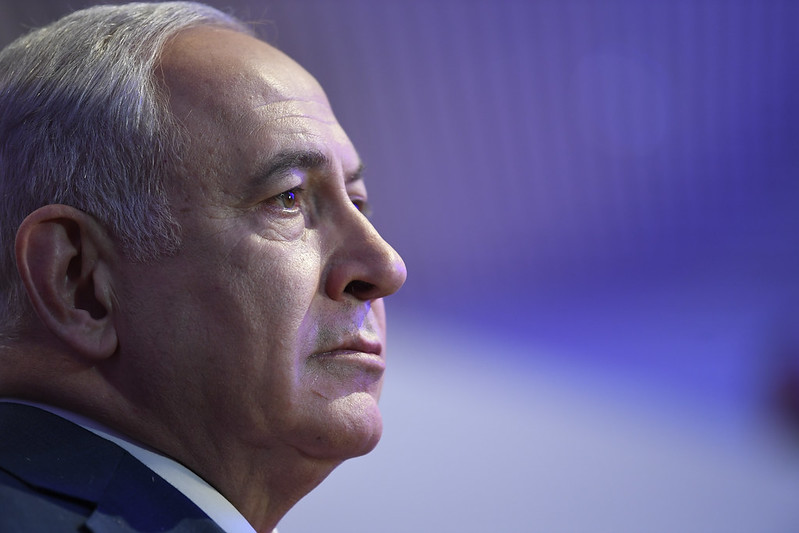Hamas says Netanyahu’s goal is genocide as the Israeli leader told a televised briefing that he had ordered troops to “prepare to operate” in Rafah, where over one million Palestinians have sought refuge.
Israeli Prime Minister Benjamin Netanyahu on Wednesday rejected Hamas’s call for a ceasefire and demanded occupation forces prepare for an offence operation in the southern Gaza city of Rafah, which has become a refuge for over one million Palestinians seeking protection from Israel’s genocidal war.
However, U.S. Secretary of State Antony Blinken said he still saw “space for agreement to be reached,” while addressing the media in Tel Aviv shortly after meeting Netanyahu.
Netanyahu, during a televised briefing, announced the occupation forces preparations for Rafah, claiming that a “total victory” for Israel over Hamas was imminent within months.
He criticised Hamas’s ceasefire demands as “bizarre” and argued that compliance would not lead to the release of captives but rather “invite another massacre.”
The Israel-waged massacres in Gaza have so far killed at least 27,708 Palestinians and wounded 67,147.
Despite citing its goal as eliminating Hamas in Gaza to justify its war, Israel has focused its attacks on civilian infrastructure, resulting in 70% of the casualties being women and children.
Responding from Beirut, senior Hamas official Osama Hamdan said Netanyahu’s “insistence on continuing the aggression totally confirms that the goal… is genocide against the Palestinian people.”
Hamdan urged all resistance factions to continue the fight, cautioning against Israeli “treachery” in the final stages of the confrontation.
A released captive, Adina Moshe, directed a plea at Netanyahu during a Tel Aviv press conference, expressing concern that the destruction of Hamas could eliminate the chance for further captive releases.
“Everything is in your hands,” Adina Moshe told a news conference in Tel Aviv, addressing Netanyahu.
“You’re the one. And I’m very afraid and very concerned that if you continue with this line of destroying Hamas, there won’t be any hostages left to release,” she said.
Meanwhile, during a bipartisan press briefing on Wednesday morning, U.S. lawmakers urged Qatar to strengthen its influence over Hamas leadership.
The call for increased pressure on Qatar was made by a delegation of Knesset members and captive families. The White House confirmed that it is examining the proposal presented by Hamas during negotiations. President Joe Biden described the proposal as “a little over the top.”
Wednesday’s reports of private talks between Hamas and Qataris, along with Doha allegedly pressuring Hamas to revise its agreement terms, were denied by sources within the Palestinian Resistance.
Sources from Al Mayadeen revealed that a Hamas delegation is expected in Cairo on Thursday for discussions with Qatari and Egyptian mediators.
The sources clarified that Hamas communicated to the mediators that military pressure “will not lead to any change in its position, including the [Israeli] attack on Rafah.”
This development comes as Hamas submitted its response to the proposed framework agreement to both Qatar and Egypt on Tuesday, following internal consultations within its leadership and with other Palestinian resistance factions.
Hamas plan proposal outlines
Hamas responded to a ceasefire deal with a detailed plan that would see an end to the war in Gaza and the release of remaining captives through a three-phase framework, according to a document seen by an Al Jazeera report on Wednesday.
The group’s response included three stages, each lasting for 45 days to enable the release of all Israeli captives and the bodies of those who died while in Gaza, lifting the siege on Gaza, and reconstructing the Strip and came after Israel had agreed to a deal mediated by Qatar, Egypt and the U.S. on Friday.
Hamas also added its demands to the proposal and made a few offers to the Israeli side. One such offer included the release of all Israeli children, women, elderly, and sick captives during the first stage.
The offer is in exchange for the release of 1,500 Palestinian detainees, including 500 serving life or long sentences, and all women, children and the elderly, according to Al Jazeera.
Reuters separately reported that the remaining male captives would be released in the second phase and the remaining would be exchanged in the third phase. The sides would agree to end the war by the time they reach the third phase.
Hamas also demanded the entry of at least 500 aid and fuel trucks per day into Gaza during the first phase, in addition to the entry of at least 60,000 temporary homes and 200,000 shelter tents.
Also during the first stage, Hamas demanded the return of all the displaced to their homes and a guarantee of their freedom of movement between the north and south, which Israel has heavily restricted since late last year.
Another demand entailed the approval of a plan for the reconstruction of homes, and commercial and public facilities in Gaza within a maximum period of three years, Al Jazeera added.
The Palestinian group requested that the truce talks end before the second phase and demanded the withdrawal of Israeli forces to begin the reconstruction process.
Hamas also had demands beyond the situation in Gaza and requested an end to the Israeli settlers’ storming of the Al-Aqsa Mosque and the return of its conditions to those before 2002.
One final detail revealed by Al Jazeera included a demand by Hamas that Qatar, Egypt, the U.S., Turkiye, and Russia guarantee the implementation of the agreement.
